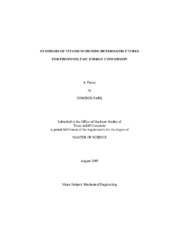| dc.description.abstract | The photovoltaic energy conversion system (PV cells or solar cells) has been researched over the last few decades, and new technologies have been proposed. At the same time, the synthesis of nano-scale materials has been investigated intensively from the 1990s. These new types of materials encourage the development of new PV technologies with extensive research. Dye-sensitized solar cells (DSSCs) can be a part of these efforts. Since first presented in 1991, DSSCs have become the center of attention due to their great advantages to the traditional silicon solar cells. However, it remains a challenge to develop better performing DSSCs since the efficiency of DSSCs is still much lower than that of high performance solar cells. To meet this challenge, the different types of TiO2 nanostructures in DSSCs have been studied.
This thesis presents the synthesis of TiO2 hetero-structures. These structures can achieve two important factors in DSSCs. One is the electron pathway for high electron transport rate, and the other is the large surface area for the dye absorption.
TiO2 hetero-structures were successfully synthesized by using a simple thermal annealing method. The synthesis method required neither a high reaction temperature nor complicated reaction processes and produced dense TiO2 nanowires and incorporating TiO2 nanoparticles with relatively short reaction time. The key parameters of growing 1-D TiO2 nanostructures were the Cu eutectic catalyst, the reaction temperatures, and the annealing time. The repetition time and the reaction temperatures were important factors for incorporating TiO2 nanoparticles.
The structure and composition of as-grown samples were analyzed using an x-ray diffractometer, a scanning electron microscope, a field emission scanning electron microscope, a transmission electron microscope and an ultraviolet-visible spectroscopy. The results showed they were crystalline structures in rutile phase of TiO2.
From this research, we can utilize hetero-structures as an electrode of DSSCs. We also expect that our simple and effective synthesis method can be used for growing other kinds of metal oxide nanostructures, especially for those melting temperature are high. | en |


